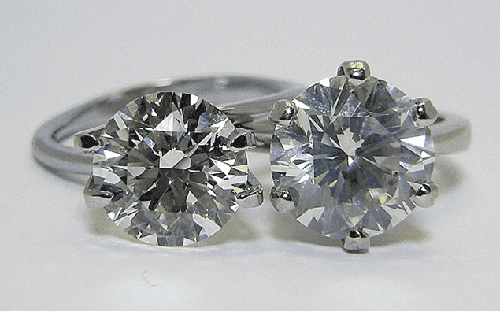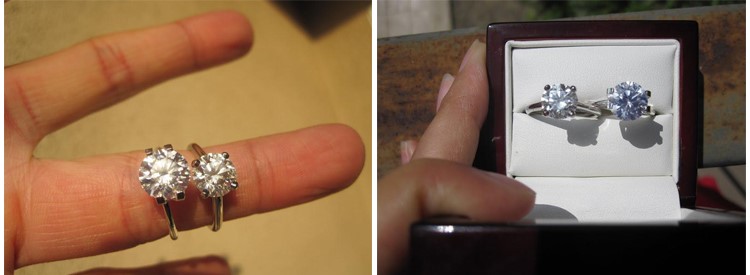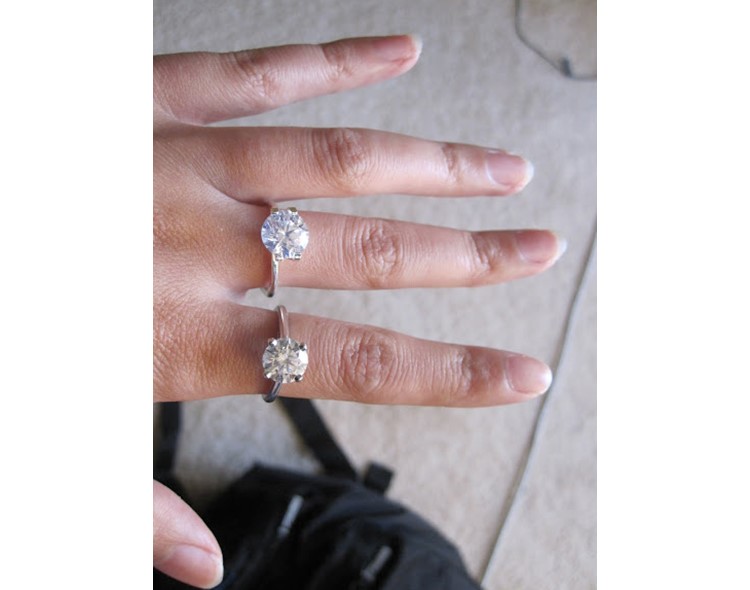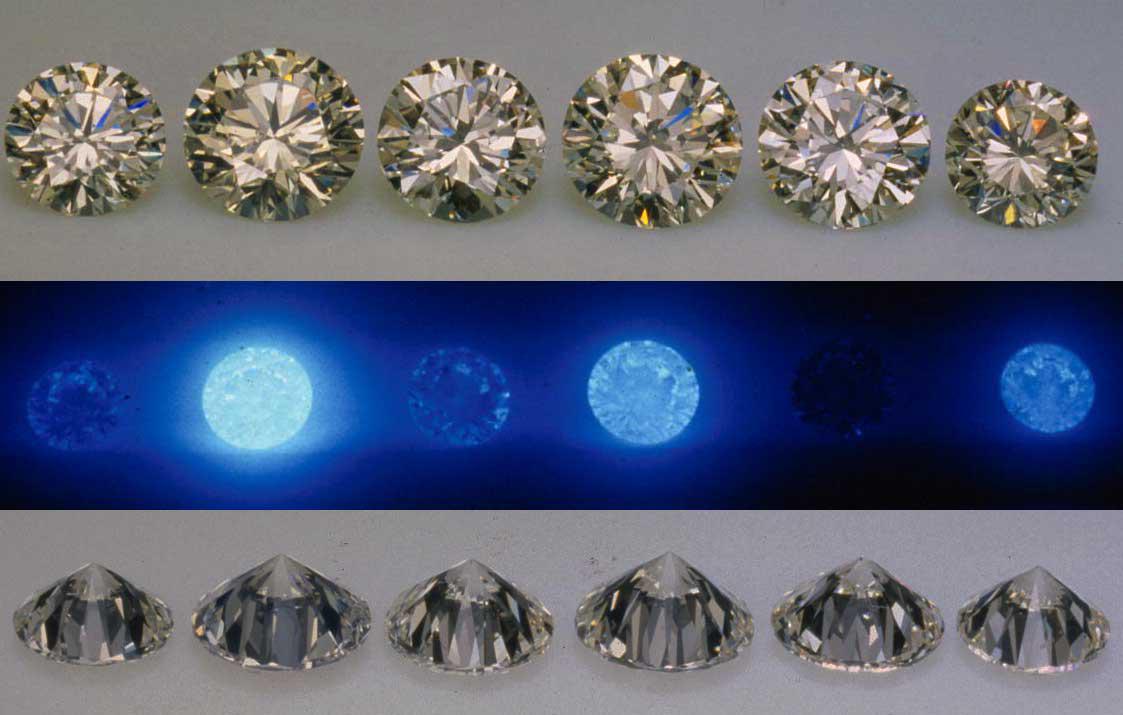Diamond Fluorescence Buying Guide | 4C's Education
A comprehensive guide to the art and science of diamond fluorescence
- Diamond fluorescence is the visible glow some diamonds emit when exposed to ultraviolet light.
- Strong or Very Strong fluorescence can make a diamond appear cloudy or hazy in certain lighting conditions.
- Rare Carat provides detailed fluorescence information to help buyers make informed decisions.
- Sometimes fluorescence can impact a diamond's appearance and value, so it's important to consider when choosing a diamond.
What Exactly is Diamond Fluorescence?
Diamond fluorescence refers to the phenomenon where a diamond emits a visible glow when exposed to ultraviolet (UV) light. It is caused by certain minerals or impurities present in the diamond's structure. Fluorescence can range from none (no fluorescence) to strong (intense fluorescence). This characteristic is graded on a scale from "None" to "Very Strong" and can impact a diamond's appearance and value. Some people prefer diamonds with no fluorescence, while others find a subtle fluorescence can enhance a diamond's brilliance. Just like all of our other diamond characteristics so far, fluorescence is judged on an increasing scale.
How Does Fluorescence Affect a Diamond?
There are two ways that fluorescence can impact the visuals of your diamond. Knowing what these are and how to navigate them, will mean that you can actually use them to your advantage!
Fluorescence Can Cause a Blue Tint
The first way fluorescence can change the look of your diamond, is through the subtle blue hue the stone might emit in certain light. Fret not my internet friend, for this does not have to be a bad thing! Indeed, for some people, this slight bluish tint is very appealing, and they actively seek it out.
For others, it can be an unattractive quality (kind of like leaving the toilet seat up - not a deal breaker per se, but certainly something that needs to be modified, quick time). If you fall into the toilet seat gang (this joke is turning out a bit weird sorry not sorry), there is a pretty cool ‘hack’ that you should know about. You see, the yellowish hue of those near-colorless diamonds (G, H, I, J and K) can often be offset by the blue undertones of the fluorescence that is present in the stone. Because of this, a ‘medium’ (and sometimes even ‘strong’) blue fluorescence can make these near-colorless diamonds appear whiter. Diamond hack!
Unfortunately, the same cannot be said for colorless diamonds (D, E, F) especially when you move into the ‘strong’ and ‘very strong’ fluorescence side, as the yellowish hue found in near-colorless stones (that balanced out the blue) is not present in these diamonds. I would steer away from the colorless with anything other than 'faint' or 'none' for fluorescence - unless of course that subtle blue (sometimes even violet) undertone floats your proverbial boat. In that case, go for it!
Fluorescence Can Cause the Stone to Look Milky/Hazy
The other main worry is that a diamond with fluorescence will exhibit a milky haze. To get an understanding of what this milkiness might look like, try to visualise what happens to water when it is put in a glass that previously held milk. The water will mix with the milk residue and the color of the water will adopt a soft murky appearance, and certain strengths of fluorescence can exhibit that same look under certain circumstances, like this one on the right below;

Figure 1 Clear diamond on the left, milky/hazy diamond on the right
Now, just like our other diamond characteristics, the importance and impact of fluorescence only becomes apparent once you progress along the scale - i.e., once you get to the ‘strong’ and ‘very strong’ categories. A ‘faint’ fluorescence will never appear milky or hazy for example, and even a ‘medium’ fluorescence will rarely look milky. Today however, I want to focus on the ‘strong’ and ‘very strong’ fluorescent categories. Diamonds with ‘strong’ blue fluorescence for instance, can sometimes appear slightly (or even severely) milky/hazy in natural light. Diamonds with ‘very strong’ will often have a haze to them no matter what the color grade is. This point about light is crucial, because change in lighting circumstances and environment can mean a change in how the fluorescence affects the stone from moment to moment;

On the left is a diamond with ‘very strong’ fluorescence, photographed indoors. The image on the right is the same diamond, photographed in the direct sunlight. As you can see, the way the diamond is behaving in the sunlight gives it a milky look. This is not to say that this is an undesirable feature, and many people will be attracted to the almost ethereal vibe this type of stone is giving off. Indeed, the presence of ‘strong’ or even ‘very strong’ fluorescence does not mean a diamond will not be beautiful. Just look at this next example of a G color stone with ‘very strong’ fluorescence (larger stone) next to an F color ‘medium’ fluorescence (smaller stone);


This is a beautiful stone, and yet another example of how a diamond can perform very differently with a change of environment (the top left-hand picture was taken indoors, the other two were taken outside). It’s also an example of why it is absolutely vital for you to ask a gemologist about the fluorescence strength before clicking the 'buy now' button.
You want to be able to see what your diamond actually looks like, in the kitchen while making yummy pasta, in the living room while binge-watching Yellowstone, or on the balcony while spying on your neighbours having an argument. You want to be able to examine your diamond on a beautiful sunny day, as well as a miserable wet and cloudy one.
In fact, purchasing your stone online really does give you a distinct advantage here. In a store - where the lighting is optimal (and usually there is little to no natural light coming in) - you would never be able to witness the true effect that fluorescence might have on your stone. Buying online on the other hand, means you have the luxury of checking the stone in lots of additional ways, allowing you to see how your new diamond will appear (and hopefully flourish) in its new home. And if it doesn’t, you can send it back for a refund (within 30 days).
Fluorescence and Price

Figure 2 The brighter the diamond appears under UV light (top row), the higher the fluorescence
When it comes to price and fluorescence, typically the stronger the fluorescence and the higher the color grade, the lower the price will be. Why? Well, 2 reasons.
First, diamonds with stronger fluorescence just really aren't that sought after. There is a stigma attached to them that they will all exhibit the negative side effects we covered up above. Is that really the case though? Definitely not. Realistically, only about 5%-7% of the diamonds on the market with strong fluorescence will have any visible side effects and it's mainly in the colorless (D-F) and G grades.
Second, since there is such a stigma against fluorescent diamonds, wholesalers will lower the price to move the goods. It stinks for them but is good for you (as long as the stone looks great in all the different types of light).
How Can You Tell if the Fluorescence is Impacting the Diamond?
It's pretty tough to do if you're not a trained gemologist and even harder if you're looking at videos online since the stone is in a controlled light environment. That's why we are here to help! Our GG's can help you look over the diamond in question and even ask the retailer for their notes on the stone before you purchase. Just click on the chat bubble for help!
This leaves you with a great way to reduce the cost of your diamond, especially if you are willing to take a chance on a fluorescent diamond. As we have seen above, not only can fluorescent diamonds be absolutely beautiful but they are a fantastic way to save some money if you know how to work the system - leaving you more cash to splash on that dream ring setting. Hurrah!

